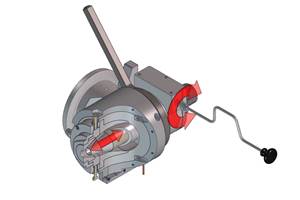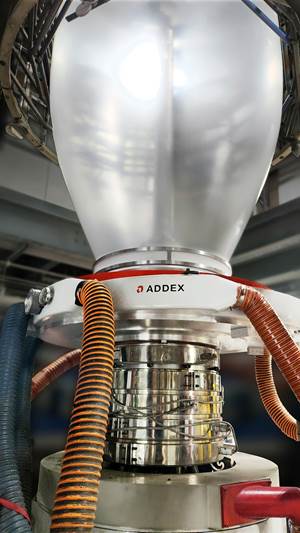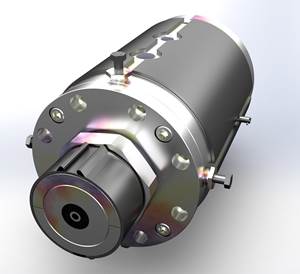‘Breakthrough’ Tech Allows for Fast Sheet-Thickness Changes
New system uses a single-point adjustment to change the lip gap and modify the lip land length at the same time.
Sheet processors can change over from one product to the next in minutes rather than hours, while improving product quality and consistency, as a result of new die technology that debuted during last month’s NPE2015 show in Orlando.
Called the SmartGap Lip and Land Positioner and developed by Nordson EDI, Chippewa Falls, Wis., the technology mechanically links the die-lip gap and the lip-land length to allow them both to be adjusted at the same time at a single-point. The company says that linking the adjustment of these two key process variables for the first time ensures a proper setup of the die and takes substantial time and guesswork out of the process for achieving desired sheet properties.
Before the show, Nordson EDI (nordsonpolymerprocessing.com) had completed alpha testing on the technology, running polyolefins and styrenics, says Sam Iuliano, chief technologist, so it will introduce the technology for these applications. “Our approach is conservative, so we will need to prove out this technology for other material types before announcing availability, but the potential is great for a broad array of applications and resin types,” Iuliano adds.
The system is available as an option for new sheet dies only. Iuliano describes the price premium as small compared with conventional technology, noting that “the investment will certainly be a sound one when the total cost of ownership is considered.” While the initial target market for the technology is sheet processors that run products in a relatively wide range of thicknesses, Iuliano notes that the technology could potentially be applied to cast film and extrusion coating in the future. The technology also is not limited in any way by the complexity of the coextruded structure.
In sheet extrusion, when processors transition to new jobs they generally have to shut down the line swap out the die lips, which can take up to 2 hr. The SmartGap system reportedly reduces changeovers to a matter of a few minutes. Moreover, the SmartGap system can reportedly accommodate die-gap adjustments over a range of 0.400 in. (10.2 mm), enabling processors to run efficiently with multiple product changes per day. At the same time, the SmartGap system enhances product quality and consistency, in part by keeping the lip faces and lip lands parallel while carrying out changes in thickness, Nordson EDI says.
HOW IT WORKS
Operators use an adjustment mechanism at the end of the die to make a new setting for the lip gap (see top image). At the same time, the lip land length is adjusted by a series of slide bars with cam grooves, which automatically position the lip components as the overall die-lip gap is changed. In that way, the lips themselves are not flexed. Changes in the length of the lip land are automatically enacted depending on the target sheet thickness.
For example, in the case of thin sheet (generally about 0.008 to 0.080 in.), the lip land would be shortened, which helps to control backpressure at smaller die gaps, reduces deflection, and lessens the need for drawdown. For mid-range sheet (0.081 to 0.225 in.) the lip land would change from short to medium length, providing sufficient pressure for adjustments to the flexible die lip while helping to reduce swelling of the extrudate. For thick sheet (0.226 to 0.370 in.), the lip land would be extended to full length, increasing backpressure at large lip gaps and helping to reduce extrudate swell (see images).
Before the SmartGap system, there have been two methods of varying the lip gap. The simplest and most common—adjusting the flexible upper lip of the die—has been used for decades, But as Nordson EDI explains it, this technique has a limited thickness-adjustment range (or “travel”), requires several adjustments across the width of the die, and requires the line to be shut down to exchange a removable lower or fixed lip to effect a stepwise change in both lip-land length and lip gap.
More recently, Nordson EDI introduced the FastGap to bend the fixed lip, which it says extended the range of travel but did not allow for any lip-land adjustment. The lip land used in this die is a compromise design of medium length.
Bending die lips over significant distances results in lip lands that are not parallel, causing undesirable diverging or converging flowpath geometry, says the company. This can exacerbate certain problems such as lip contamination that leads to streaks. When there is either no provision for a lip-land change or lip-land change procedures are too time-consuming, processors will often struggle with sheet quality. This is especially true at the thinner and thicker extremes of their product range, where a medium-sized lip land is less appropriate.
HIGHER QUALITY & CONSISTENCY
Nordson EDI says the new system can improve sheet quality and consistency in a number of ways. For one thing, since SmartGap technology makes it more convenient for processors to set smaller lip gaps, they don’t need to draw down the sheet as much to achieve target gauge. As a result, there is less orientation of the sheet and fewer problems with shrinkage. The technology is also said to generate sheet with tighter tolerances and better layflat.
Explains Iuliano, “Now that more appropriate lip land lengths are available for small and large lip gaps, use of the flexible lip to fine-tune the gauge profile is more effective. In addition, a proper lip-land to lip-gap ratio prevents excessive extrudate swell that causes visible corrugation defects. Improved lip geometry also yields a more fully developed flow, which results in more uniform orientation and less warpage.”
What’s more, a reduction in extrudate swell helps avoid streaks and reduces the tendency of lip faces to become contaminated. Defects such as shark shin, which can result from running with a die gap that is too small, can be avoided because SmartGap provides good thickness control at larger die gaps, says Nordson EDI. Also, since the SmartGap system slides the lip components, instead of flexing them through an arc, the lip lands will remain parallel and the lip faces stay flush and normal, according to the company. This keeps the lip geometry ideal for use with external deckles, since the deckle seals do not need to conform to irregular lip faces. The result is that external deckles seal better and require less maintenance, Nordson EDI explains.
Related Content
Crosshead Die for Elastomers Adjusts Easily
NPE2024: Mechanically actuated gum space adjustment requires only ordinary socket wrench.
Read MoreAuto-Profile System for Blown Film Rotating Dies
NPE2024: New technology can slash gauge variation by 50%.
Read MoreSpiderless Pipe Die Touts Material Savings
Capable of providing a finished extrusion with OD from 2 in.-15 in.
Read MorePart 2 Medical Tubing: Use Simulation to Troubleshoot, Optimize Processing & Dies
Simulation can determine whether a die has regions of low shear rate and shear stress on the metal surface where the polymer would ultimately degrade, and can help processors design dies better suited for their projects.
Read MoreRead Next
See Recyclers Close the Loop on Trade Show Production Scrap at NPE2024
A collaboration between show organizer PLASTICS, recycler CPR and size reduction experts WEIMA and Conair recovered and recycled all production scrap at NPE2024.
Read MoreLead the Conversation, Change the Conversation
Coverage of single-use plastics can be both misleading and demoralizing. Here are 10 tips for changing the perception of the plastics industry at your company and in your community.
Read More

























